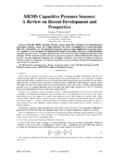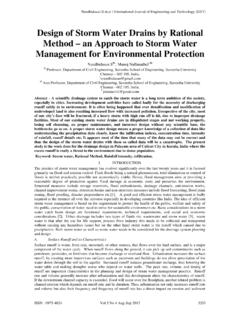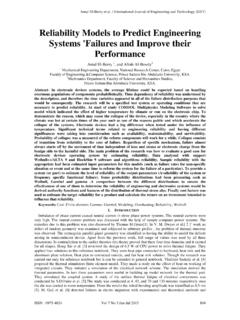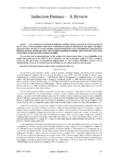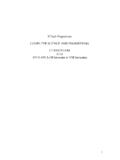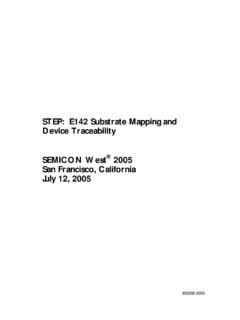Transcription of GIS-based River Flood Hazard Mapping in Urban Area (A Case ...
1 Sina alaghmand et al. / International Journal of Engineering and Technology (6), 2010, 488-500. GIS-based River Flood Hazard Mapping in Urban Area (A Case Study in Kayu Ara River Basin, Malaysia). Sina Alaghmand1, Rozi bin Abdullah2, Ismail Abustan2 and Behdokht Vosoogh3. 1. Student in Water Research Centre, University of South Australia Address: H2-19, Water Research Centre, Mawson Lakes Campus, University of South Australia, 5095, Adelaide, Australia. H/P: +61405090947. Email: 2. Assoc. Prof. of School of Civil Engineering, Universiti Sains Malaysia (USM). 3. Student in Department of Water Engineering, Gorgan University of Agricultural Sciences and Natural Resources, Iran Abstract: In the past decades, thousands of lives have been Hazard is defined as threatening event, or the lost, directly or indirectly, by flooding. In fact, of all natural probability of occurrence of a potentially damaging hazards, floods pose the most widely distributed natural Hazard phenomenon within a given time period and area.
2 Hazard to life today. Sungai Kayu Ara River basin which is located in refers to the probability of a potentially dangerous the west part of the Kuala Lumpur in Malaysia was the case study of this research. In order to perform River Flood Hazard phenomenon occurring in a given location within a Mapping HEC-HMS and HEC-RAS were utilized as hydrologic specified period of time [3]. Thus, it can be defined that and hydraulic models, respectively. The generated River Flood Hazard (or cause) as a potential threat to humans and their Hazard was based on water depth and flow velocity maps which welfare and risk (or consequence) as the probability of the were prepared according to hydraulic model results in GIS specific Hazard occurrence [4, 5]. Human practices such as environment. The results show that, magnitude of rainfall event the alteration of natural drainage, the creation of landfills, (ARI) and River basin land-use development condition have or the destruction of the natural environments and significant influences on the River Flood Hazard maps pattern.
3 Increased groundwater extraction may radically alter the Moreover, magnitude of rainfall event caused more influences pattern of the Hazard behaviour. Results of human on the River Flood Hazard map in comparison with land-use development condition for Sungai Kayu Ara River basin. habitation such as unplanned rapid Urban development, uncontrolled logging of natural forests or major changes in land-use can influence the spatial and temporal pattern of I. INTRODUCTION the hazards. River Flood Mapping is the process of determining Starting in the year 2000s, extreme rainfall events with inundation extents and depth by comparing River water high intensity are not longer a new issue in Malaysian levels with ground surface elevation. The process requires Urban cities, especially in the West Coast area. This the understanding of flow dynamics over the Flood plain, phenomenon is formed mostly through convection process topographic relationships and the sound judgments of the [1].
4 Hence, flooding is one of the major natural hazards modeller [4, 6]. Flood Hazard maps produced may include affecting communities across Malaysia and has caused water depth, Flood extent, flow velocity and Flood duration. damages worth millions of dollars every year. The required This is a basic and important indicator for the Flood plain allocation for Flood mitigation projects has increased land use development planning and regulations [7]. River almost 600% (RM 6000 million) for the 8th Malaysian Plan Flood Hazard Mapping was first initiated in 1988 in the compared to RM 1000 million during the 7th Malaysian United States by the Hydrologic Engineering Centre (HEC). Plan [2]. of the Army Corps of Engineers [5, 8]. The purpose of River Flood Hazard management is the process under the study is mainly to produce Flood Hazard maps for the which different bodies try to reduce the current and the National Insurance Program (NFIP) due to the reluctance future vulnerability of human society to natural hazards.
5 Of private insurance industry in providing insurance The main objectives of River Flood Hazard Mapping can be policies as a result of catastrophic losses [5]. All the sorted as follows: to prevent loss of life, to minimize existing methods for Flood plain Mapping can be grouped property damage, to minimize social disruption and to into the following three major categories namely the encourage coordinated approach for land/water use. The analytical method, the historical method and the role of Flood Mapping in River engineering is an important physiographic method [9]. All these three methods share feature in planning and management: basis for managing two common steps for Flood plain Mapping ; determination Flood plains, engineering & planning tool, first step in Flood of water surface profiles and transfer of water elevation plain management, part of legislation for regulating from profiles to maps. Essentially these three methods use development and basis for pursuing structural and non- the same procedure to delineate Flood plain boundaries by structural measures.
6 Determining the Flood elevation at each River cross section. The boundaries are then interpolated between the cross ISSN : 0975-4024 488. Sina alaghmand et al. / International Journal of Engineering and Technology (6), 2010, 488-500. section. The three methods differ only in their way of The introduction of framework based system integrating determining the water surface profile. Only the analytical the object-oriented methodologies in creating modelling approach can meet the requirement of the Urban Storm- tools using Windows Graphical User Interfaces (GUIs). water Management Manual for Malaysia (SWMM), as may provide an understandable and highly visualized specified in Volume 4, Chapter 11 which requires that any output for both the hydraulic experts and non-specialist new development proposals should include base Flood users [21, 23, 25-27]. This concept has also alleviated the elevation (BFE) information [10].
7 These three methods are desired modularity and re-use of the existing modules in labour-intensive, involving the manual interpretation of software developments [23, 28, 29]. In general there are aerial photos and contour maps and full of uncertainties four methods for incorporation of River basin models into during the entire Mapping process. Because of the high cost GIS. They are classified as stand alone system, loose incurred, Flood plain maps are very difficult to update using coupling system, tight coupling system and embedded these traditional manual methods [4]. Nowadays, scientists system. In this regard, two ArcGIS extensions which were and engineers take advantages from computer modelling utilized in this research to incorporate River basin into GIS. techniques in determining River Flood modelling. Computer were HEC-GeoRAS and HEC-GeoHMS those are models for the determination of River Flood generally classified as tight coupling system.
8 These GIS extensions consists of four parts [11], these are: were used to extract the geometry input data and also River i. The extraction of geospatial data for use in the Flood visualization [30-36]. hydrological and hydraulic models (HEC-GeoHMS and HEC-GeoRAS). II. MATERIALS AND METHODS. ii. The hydrologic model which develops rainfall-runoff Sungai Kayu Ara River basin is the case study in this from a design rainfall or historic rainfall event (HEC- research which is located in Kuala Lumpur, Malaysia. HMS). Sungai Kayu Ara River basin is geographically surrounded iii. The hydraulic model which routes the runoff within N 3 6 to N 3 11 and E 101 35 to E 101 39 . through stream channels to determine water surface Figure 1 illustrates the location and base-map of the Sungai profiles (including depth and velocity) at specific Kayu Ara River basin in Malaysia, respectively. locations along the stream network (HEC-RAS).
9 Iv. A tool for floodplain Mapping and visualization (HEC- GeoRAS). Combination of the hydraulic series data within a spatial interface, such as a Geographical Information System (GIS) and Remote Sensing (RS), are the key to graphical visualizations on the hydraulic modelling. The increasing availability of very high performance GIS. software packages such as ArcGIS offers new opportunities for engineers to perform Flood inundation analysis in conjunction with hydraulic models with interactive visualization within immerse decision support environments [4, 12-15]. The GIS technology has the ability to capture, store, manipulate, analyze, and visualize the diverse sets of geo-referenced data [16-18]. On the other hand, hydraulic is inherently spatial and hydraulic models have large spatially distributed data requirements Fig. 1. Location and Base Map of Sungai Kayu Ara [6, 19, 20]. The integration of hydraulic model and GIS is therefore quite natural.
10 The GIS allows modulation and simulation of different scenarios and the graphic Sungai Kayu Ara River basin covers an area of representation of the different alternatives. km2. The main River of this River basin originates from the In recent years, efforts have been made to integrate reserved highland area of Penchala and Segambut. The hydraulic models and GIS to facilitate the manipulation of Sungai Kayu Ara River basin can be a suitable study River the model output which led to the establishment of a new basin for this research because of some reasons such as branch of hydraulics and hydrology, namely, hydro- follows: primarily, a large part of this River basin area is informatics [21-23]. Hydro-informatics encompasses the well developed Urban area with different land-use and also use of advanced information technology procedures to high population density that shows the importance of this improve the level of technology in predicting the governing River basin.


